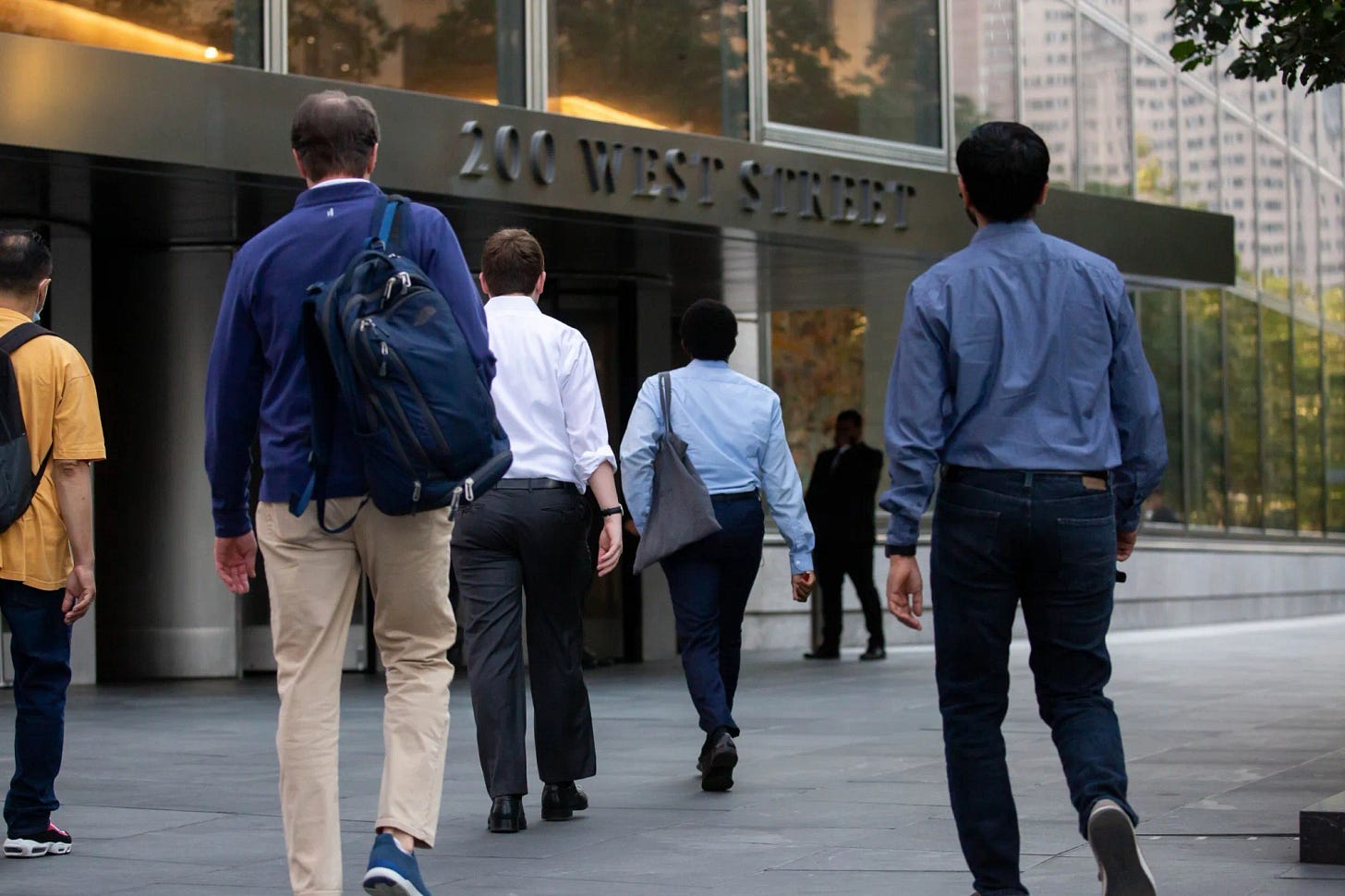Will Government Ever Be Ready to Go Back to the Office?
Do public servants have a responsibility to work from the office?
Last month Philadelphia Mayor Cherelle Parker announced that she will be requiring city workers to return to the office (RTO) five days a week as of July 15th. The demand is currently the subject of city council hearings and is being disputed by city workers, but if Parker prevails, she might be one of the first mayors of a major American city to get her workforce back to the office full time. As I searched for examples of full RTO, I could only find examples of smaller governments, such as Mecklenburg County (6,000 employees) near Charlotte, which goes back to five days a week as of July 1st. The mayors of New York City and Washington, D.C. both asked for full RTO and settled for four days a week in office.
While corporate CEOs of companies from UPS to Tesla have pushed for full RTO in recent months, the public sector has remained a largely hybrid workforce. Most city governments are requiring three or four days in office, while some federal departments such as the U.S. Department of Housing and Urban Development only require one day a week in office.
But there is concern that maintaining a hybrid workplace is no longer the appropriate policy for government workforces. Government is a major employer — in Philadelphia, the federal government and the city government are the second and third-largest employers, respectively, and collectively employ more than 50,000 people. A 40 percent reduction in their in-office days has a serious financial impact on the city as office workers have been shown to spend $51 per day on transportation, lunches out, and spontaneous spending in town.
Government’s remote workdays are also depressing ridership recovery levels. In Philadelphia, SEPTA’s ridership recovery remains below national public transit averages at 80 percent of pre-pandemic levels on buses and just 62 percent on the subway.
Finally, government is maintaining leases or ownership of office buildings that are well below their pre-pandemic occupancy, and thus essentially paying for empty office space. This is particularly a problem for the federal government, which spends “about $2 billion a year to operate and maintain federal office buildings regardless of the buildings’ utilization. In addition, agencies spend about $5 billion annually to lease office buildings,” according to the Independent Institute. A Government Accountability report noted that offices for 17 out of 24 federal agencies are less than 25 percent occupied. Last month Senators Mitt Romney and Joe Manchin proposed the Back to Work Act of 2024 which would require federal workers telework no more than 40 percent of any pay period, noting that empty federal office buildings waste millions of taxpayer dollars every day.
It’s possible that Mayor Parker is asking for full RTO not just because it’s good for the city’s economy or because she thinks it will make her staff more productive, but because she wants to send a message. Parker believes in signals, symbols and vibes — clearing the drug mecca of Kensington, having a “One Philly” slogan chanted at events, focusing on cleaning streets. Full RTO fits squarely within that framework. It conveys her seriousness about bringing back downtown and her need for a more engaged employee base. It also feels a bit like an equity play to ask staff back to the office: why should only white-collar workers get the benefits of remote work?
On the one hand the full RTO may attract mission-driven younger employees who want in-person workplaces. And the clarity around in-person work expectations can be really, truly helpful in getting staff to be on the same page, doing their best work.
But most likely requiring five days in office will also cause many solid, hard-working employees who need the flexibility of hybrid work for caregiving to seek employment elsewhere. And it will deprive public employees of one of the benefits their peers often enjoy in the private sector.
According to a recent study about telework by the National Capital Planning Commission:
While agencies seek to attract younger talent, they must adapt to the changing demands of a younger workforce. Notably, since the onset of the pandemic, teleworking and location flexibility have become essential expectations for much of the labor force, especially for younger workers and mid-career professionals... In the modern workforce landscape, teleworking has emerged as a crucial expectation and often a necessity to keep a competitive edge in talent recruitment for younger workers seeking employment opportunities within the federal sector
In the past, public servants at least got a pension. Today when they’re given performance bonuses, they’re the subject of a New York Times investigation and congressional inquiry. There needs to be a larger conversation about what kind of HR strategies we think governments should have. If we want government to be able to attract and retain the best and brightest, they’re going to need to work from a similar playbook as private sector companies — and they can’t be pilloried for it.
But the real injustice here isn’t that any employer wants their staff back at work, face-to-face, five days a week. It’s that this demand sets so many Americans up for failure.
In other countries like South Korea and France, only 2 to 3 percent of employees work remotely. In their cities, commutes are shorter and more likely to take place on foot, bike, or public transit.
To help caregivers balance work and family, Belgium has legislated a four-day work week. In 2021, Lithuania enacted legislation to enable a four-day work week for parents. European countries have found a way to prioritize in-person work, while also acknowledging the need for more personal time for caregiving or other life needs. And this European vision around four days per week in office and an extra day of no work seems like a much better mix than the American default of working all the time, often remotely, without the same core days for everyone.
We need a greater realization that the American obsession with remote work stems from a lack of affordable housing near job centers or along quality transit lines, a lack of caregiving supports, and frankly a cultural devaluation of the importance of being present and in person with others on a regular basis. Calling people back to the office five days a week without addressing these other systemic issues feels unfair because it doesn’t seem to acknowledge this context.
Unlike private sector CEOs who can’t do much to effectuate change in the public realm, government leaders actually are positioned to do more to address the societal problems underlying full RTO. Local and federal leaders can take this moment to gather data and insights into employees’ barriers for full RTO, and then use those grievances, whether about commutes or inadequate time for caregiving to take action on these issues at the local or federal level, rather than push the responsibility for addressing these issues to employees. This could look like dramatically increasing transit-oriented development to create more housing near city halls or ensuring all public schools have high-quality aftercare options to reduce the burden on caregivers. Employee feedback might lead them to, ironically, institute a four-day workweek trial and see if five days a week in office is that much better for the economy or employee productivity.
If you enjoyed this piece, have been reading this column for a long while, and want to see it continue, please consider becoming a paid supporter here!
You May Also Like:











I'm in a back of house IT role at a public university, and the state government's reluctance to embrace remote work, among other things, making it difficult for us to compete with the private sector for talented job candidates is a common watercooler topic. On the surface, I feel like we should be more flexible, but only to a point... when I imagine doing a 100% remote job for an employer on the other side of the country, it's pretty depressing. My field has a disproportionate number of recluses who love this, but I don't personally.
My ideal for jobs like mine would be in-person by default, with the option to take remote days in whole or in part as needed, no questions asked, no anxiety-inducing hard limits on the number of days per week or year or anything like that. Furnish people with office space, expect them to live locally, but don't nitpick over where they are at any given moment, so long as they are consistently reachable during core operating hours. This is based on a premise that people actually like being there and won't just never come in if left to their own devices, but sometimes they need to run an errand, or receive a package, or give someone a ride, or claim a little extra time that day by not getting dressed for the office, or sometimes someone just wakes up with an inexplicable but clear feeling that they'd do better work if they sat down and got right to it in the quiet of home instead of going through the morning ritual and traveling to the office. People are different, and some may do this more often than others, but I don't see a problem with it if they are generally "around." Maybe somebody needs a change of scenery to refocus and takes what they're working on to the coffee shop down the street for a couple of hours... or maybe that goes so well that they stay there for the rest of the day.
Some will certainly raise concerns about abuse, but we've already run the experiment that remote work in and of itself doesn't destroy employee productivity. Why not offer a flexible middle ground that acknowledges the importance of in-person communities without making people feel like they're being shoved back into a box? Some places are already de facto somewhat like this, but I'd like to see it more openly acknowledged, rather than being something your boss might let you do if you're lucky enough to have one who finds it reasonable, or you have some kind of personal capital that earns you extra leeway.
I guess what this amounts to is a different kind of hybrid approach, where instead of saying this person is remote on these two or three days a week, the default is in-person every day, but someone may be remote on any given day, if they don't have any in-person obligations on the calendar and they determine it would help them out. I'd really like to see us move towards stronger location-based communities while also moving away from the old industrial era mindset that people need to be punching in and out all at the same time, with tedious allotments of 15 minute breaks and one hour lunches and so on. Managers should be able to know their employees and gauge whether they're taking care of things sufficiently well. Really, though, over and above any of this, we need to fix our cities as you say, so going to the office isn't something so many people find onerous.
Great article! One of the challenges that RTO has faced at Austin's City Hall is that so many city workers got priced out of the city. In the same you can't have community policing if police can't afford to live in their community, your local government will not be as responsive to the needs of its citizens if city employees aren't themselves invested in the community. I also think that, for reasons of accountability and transparency, it's really important that citizens know where their government is—which means where the people who comprise it are—and have the means to access it. A remote-working government is a government that's remote from the citizens it represents.